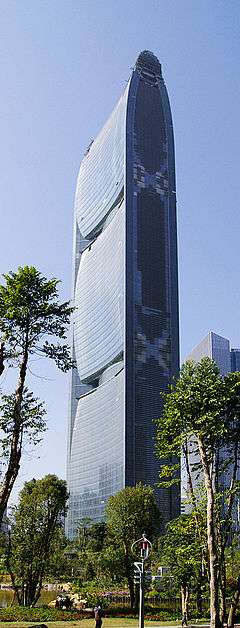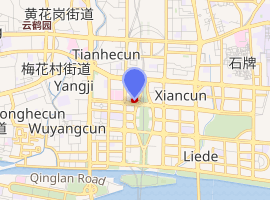Pearl River Tower
Pearl River Tower (Chinese: 珠江城大厦; pinyin: Zhūjiāng chéng dàshà; or Chinese: 珠江大厦; pinyin: Zhūjiāng dàshà) is a 71-story, 309.6 m (1,016 ft),[5] clean technology neofuturistic skyscraper at the junction of Jinsui Road/Zhujiang Avenue West, Tianhe District, Guangzhou, China. The tower's architecture and engineering were performed by Skidmore, Owings & Merrill with Adrian D. Smith and Gordon Gill (now at their own firm, AS+GG) as architects.[6] Ground broke on the tower on 8 September 2006 and construction was completed in March 2011. It is intended for office use and is partially occupied by the China National Tobacco Corporation.[7]
| Pearl River Tower | |
|---|---|
珠江城大厦 | |
 | |

| |
| Alternative names | Guangdong Tobacco Building |
| General information | |
| Status | Complete |
| Type | Commercial offices |
| Architectural style | Neo-futurism |
| Location | Zhujiang Avenue West Guangzhou, China |
| Coordinates | 23.12675°N 113.3176°E |
| Construction started | 28 September 2006 |
| Completed | March 2011 |
| Owner | China National Tobacco Corporation |
| Height | |
| Roof | 309.6 m (1,016 ft) |
| Technical details | |
| Floor count | 71 (+5 basement floors) |
| Floor area | 212,165 m2 (2,283,730 sq ft) |
| Lifts/elevators | 29 |
| Design and construction | |
| Architect | Gordon Gill Skidmore, Owings & Merrill Guangzhou Chengzong Design Institute |
| Developer | Abu Zayyad Holdings . |
| Structural engineer | Skidmore, Owings & Merrill |
| Main contractor | Shanghai Construction Group |
| References | |
| [1][2][3][4][5] | |
Architecture and design
The design of the Pearl River Tower is intended to minimise harm to the environment and it will extract energy from the natural and passive forces surrounding the building.[8] Major accomplishments are the technological integration of form and function in a holistic approach to engineering and architectural design.[9]
Sustainability
The building is designed with energy conservation in mind, including wind turbines and solar collectors, photovoltaic cells, underfloor air distribution, and radiant heating and cooling ceilings. It is one of the most environmentally friendly buildings in the world.[10]
Of Pearl River Tower’s accomplishments, many are related to the sustainable design features include:
- The largest radiant-cooled office building in the world
- Most energy efficient super-tall building in the world
- The tower is an example of China’s goal to reduce the intensity of carbon dioxide emissions per unit of GDP in 2020 by 40 to 45 percent as compared to the level of 2005.[11]
In a report presented at the 2008 Council on Tall Buildings and Urban Habitat it was reported that the building's sustainable design features will allow a 58% energy usage reduction when compared to similar stand alone buildings.[12] The building would have been able to be carbon neutral and actually sell power back to the surrounding neighborhood if the micro-turbines had been installed into the building. However the local power company in Guangzhou does not allow independent energy producers to sell electricity back to the grid. Without the financial incentive to add the micro-turbines the developers removed them from the design. If they had been added excess power would have been produced from the building, at the very least, after office hours when the power needed by the building itself had been reduced.[12]
Timeline
- Fall 2005 : Design Competition
- 8 September 2006 : Ground Breaking Ceremony
- November 2006 : Enabling Works begin
- 18 July 2007 : Public bidding for the construction[13]
- January 2008 : Main Package construction begins −26.2 m (−86 ft)
- August 2008 : Building Core construction reaches ground level 0 m (0 ft)
- April 2009 : 15th Level 80.6 m (264 ft)
- November 2009: Glass curtainwall installation begins
- December 2009: Building reaches upper wind turbine level
- 28 March 2010: Topped-out[14]
References
- "Pearl River Tower". CTBUH Skyscraper Center.
- Pearl River Tower at Emporis
- "Pearl River Tower". SkyscraperPage.
- Pearl River Tower at Structurae
- "Projects: Pearl River Tower". Skidmore, Owings & Merrill. 2012. Retrieved 26 April 2016.
- Smith, Adrian (2007). The Architecture of Adrian Smith, SOM: Toward a Sustainable Future. Images Publishing Group Pty Ltd. p. 556. ISBN 1-86470-169-2.
- "The winds of change". World Architecture News. 22 August 2006. Archived from the original on 19 October 2014. Retrieved 23 May 2012.
- "Net Zero Energy Design". SOM. Archived from the original on 1 April 2009. Retrieved 11 April 2009.
- Kyra Epstein (Winter 2008). "How Far Can You Go? Case Study: Pearl River Tower". High Performing Buildings Magazine. Retrieved 2 May 2012.
- Pearl River Tower at Glass Steel and Stone (archived)
- "China to cut 40 to 45% GDP unit carbon by 2020". China Daily. 26 November 2009. Retrieved 23 May 2012.
- Frechette, R; Gilchrist, R (March 2008). "Towards Zero Energy: A case study of the Pearl River Tower, Guangzhou, China". Council on Tall Buildings and Urban Habitat: pg. 9. Archived from the original on May 26, 2016. Retrieved November 14, 2013.
- "Guangzhou, the third high-rise tender requirements super energy-saving". Yangcheng Evening News. 18 July 2007. Retrieved 11 April 2009.
- "SOM-Designed Pearl River Tower Topped Out in China". Archived from the original on 2010-04-04.